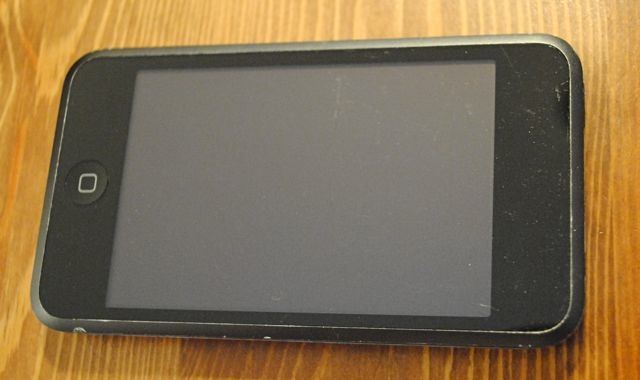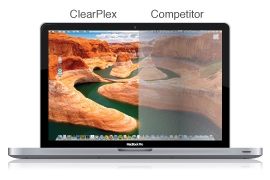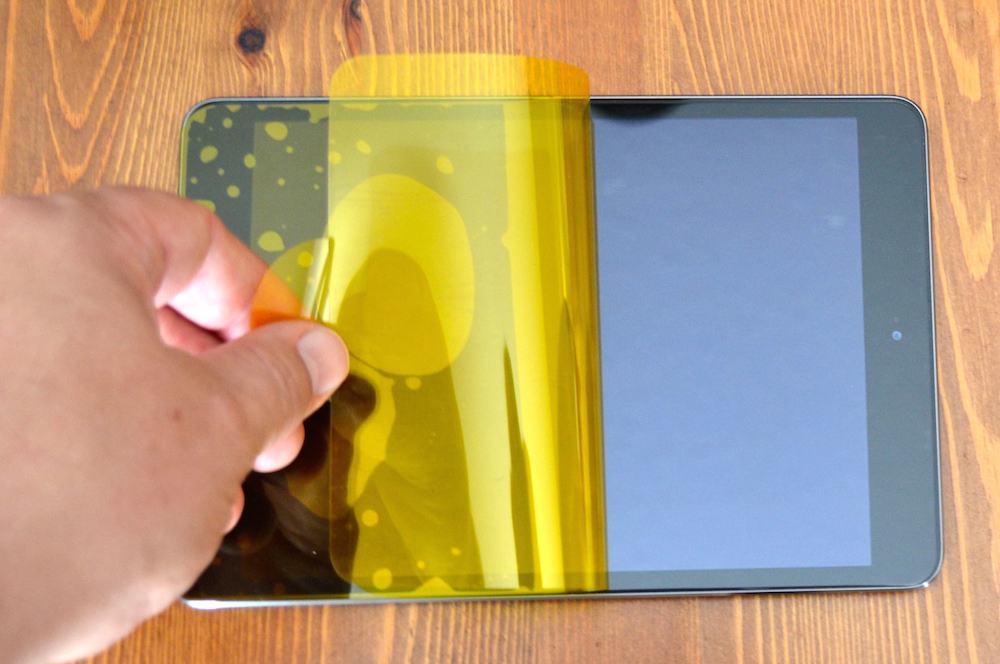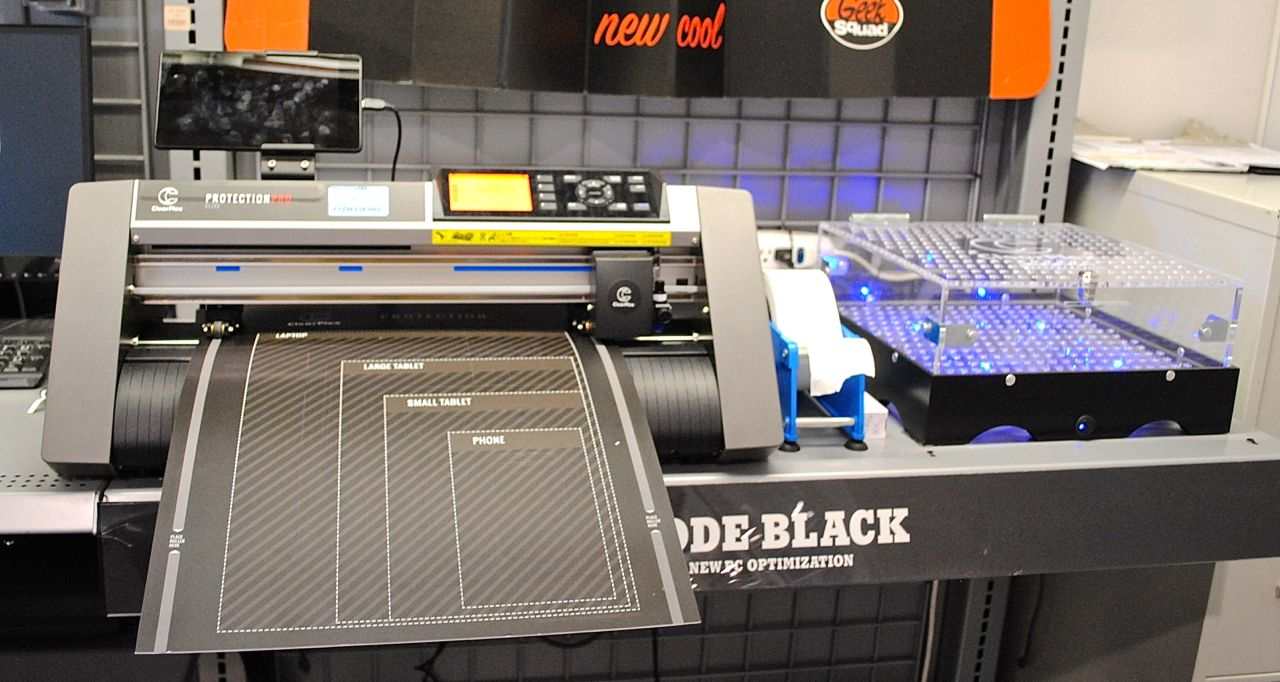
When it comes to our mobile devices —whether that be a smartphone, tablet, laptop computer, iPod or even a camera— the component that causes the most worry is usually the display. Scratches and cracks make for a subpar experience and expensive repairs. That’s why screen protectors are so popular. But these products have their limitations too, primarily the fact that they’re only available for current and highly popular devices. There’s also the matter of installation, which can be sticky and nerve-wracking. ClearPlex is exciting because it brings tough, invisible film first developed for auto windshields to consumer electronics. The company’s agreement with Best Buy has high tech ClearPlex equipment onsite at GeekSquad facilities. GeekSquad handles the programming and installation, you get ClearPlex protection customized for your device. I visited a Best Buy location in London to see the system in action, and it’s pretty cool.
Damaged Displays Are a Bummer
Scratched and cracked displays can happen to anyone. I’ve suffered the consequences myself.
An iPad one of my kids dropped onto a hardwood floor is one example. It was in a protective case, but the display itself wasn’t covered and it hit something, resulting in fractures across the glass.
My DSLR was stored safely in a closet, in a camera bag, but something banged against it and the display was cracked —that ended in a repair costing nearly $300. Here’s what the cracked camera display looked like (photo taken with a camera that wasn’t broken):

There’s no guarantee that protective film covering the display would have saved me from an expensive fix, but ClearPlex says its version increases break resistance by up to 39%.
Countless devices with micro abrasions on the display that ends up making it look cloudy. This happens all the time, especially when a phone is carried in a purse or pocket, or a tablet jostles around in a backpack. Take a look at one of my older iPods for a perfect example of this effect. It was always carried in a pocket, didn’t have anything protecting its display and as a result the glass has so many tiny scratches it looks almost cloudy.

Display Protectors Work (Some Better Than Others)
Installing a high quality screen protector on your device puts a layer of protection over the display so its glass is never in direct contact with objects that could scratch it. It also offers impact protection, adding strength to this fragile component.
 Some display protection solutions are better than others.
Some display protection solutions are better than others.
Lower quality films can add a hazy appearance to the display they’re covering —in a worst case scenario they can yellow with age. Too thick and they can introduce distortion in the image. You didn’t pay for a bright, crisp mobile display only to have it dimmed or made fuzzy. With touchscreen devices, having any kind of texture can interfere with the operation or make them feel unpleasant to use.
Ideally, you want something that’s thin, glass-like, strong and with the highest possible optical clarity.
Limited Variety
Third part display protectors are very much driven by supply and demand. If you own a new device that’s selling like hotcakes —a new iPhone 5s, for example— then finding a screen protector for it shouldn’t be too difficult.
But manufacturers of screen protectors won’t go to the expense of producing versions for devices that sell in lower volumes. It’s just not economically viable to do so. The same deal for making versions for older devices. And even if these products were available for the huge variety of mobile devices out there, no store has the shelf space available to stock each and every one.
I’ve gone the route of trying to “adapt” a peel on-plastic film adhesive protector meant for one device to make it fit an older one. It sounds easy enough —we all know how to use scissors— but trust me, the results just aren’t the same.
To make a long story short, if you’ve decided that display protection is a smart investment, you’d better hope your device is relatively new and relatively popular.
Installation Isn’t Always Fun
If you’re able to buy a screen protection system for your device, it’s time for the fun part: installation.
I say “fun” somewhat sarcastically. I’ve installed film and rigid versions on several of our devices and it’s always a bit nerve -wracking. The manufacturers do everything they can to simplify things, but there’s no getting around the fact that installation is the worst part.
 First you have to ensure the display surface is completely clean and free of smudges. Anything left on it will be trapped by the protective film, so this is a critical step. I’m always worried that any handling of the device during preparation is adding a new smudge to the glass, or that a tray dog hair is going to float across the room and land on it at the worst possible moment.
First you have to ensure the display surface is completely clean and free of smudges. Anything left on it will be trapped by the protective film, so this is a critical step. I’m always worried that any handling of the device during preparation is adding a new smudge to the glass, or that a tray dog hair is going to float across the room and land on it at the worst possible moment.
Once the preparation is complete, you have the truly tense part of the operation: removing the protective backing and positioning a sheet of film in a way that’s perfectly aligned with the display and any buttons or cutouts. Most manufacturers say you can adjust the sheet or even quickly remove it and try again, but this is the part that I hate.
If everything isn’t lined up perfectly, looking at the imperfection is going to bug you more and more as time goes on. In my experience, the bigger the display, the less pleasant the experience. With a smaller device it’s a little easier to visually line things up. A bigger surface makes that tougher and a slight mistake at the start can multiply to the film being noticeably crooked by the time you reach the end. There’s also the risk of bubbles, an annoying imperfection that can take hours (and sometimes days) to slowly work out from under the film.
If everything goes perfectly, the results are great. But when things don’t go quite the way you’d hoped, you can end up with an unprofessional-looking result and a sticky mess to clean up.
ClearPlex Advantage(s)
Two things immediately stood out about the ClearPlex system.
- Instead of buying a pre-made product, the ClearPlex system uses what is essentially a CNC mill and a sheet of adhesive plastic film. You don’t pick a pre-packaged product off the shelf, you speak to a GeekSquad agent who programs your device into the CNC Mill and feeds the raw material into the machine. A few seconds later (you’ll see the cutter head furiously zipping around as it precision cuts the sheet to the exact dimensions), the customized screen protector is ready.
- You aren’t stuck with the onerous task of installing the ClearPlex protective film. Someone who’s trained and has experience in doing this every day takes expert care of that chore. Once the film is applied, the ClearPlex system includes a “curing” station (the clear plexiglass with the blue-ish glow in the photo) where the film is bonded so that it won’t move.

In other words, it doesn’t matter if you have the newest device on the market or the most popular one —because the GeekSquad agent can program the ClearPlex system with your specific device model, you get a custom-fitted display protector.
You don’t have to worry about the fiddly, sticky stuff —installation is taken care of so you’ll be much happier with the end result.
And yes, like other protective films, ClearPlex is removable if you change your mind later. Take it off and the glass will be pristine below.
ClearPlex History
One of the unique aspects about ClearPlex is its history. The company has been involved in the automotive industry for years, producing protective film that’s applied to vehicle windshields to prevent cracks and chips.
When it comes to cars and trucks, protecting glass from breaking isn’t just a matter of avoiding costly repair bills (although preventing windshields from breaking after being hit by a rock does save a lot of money), it’s a matter of safety.
Using the ultra-tough, optically superior film that has been developed to protect cars and even fleets of big rigs from damage to protect the displays of consumer electronics seems like a great idea. If the material is tough enough to take the impact of debris on the road and its optical quality is good enough that it can be applied over a windshield without negatively impacting the driver, then it seems like a natural fit.
Protect Your Electronics
You’ve seen what can happen to unprotected electronics. If my scuffed up iPod, smashed iPad or cracked DSLR isn’t enough to make the case that a protective screen display is a good idea, I don’t know what will. Think of it as insurance for your electronics if that helps. Even if you have an older device, you’re not left out thanks to that programmable ClearPlex CNC and its highly customizable output.
Here’s a final bit of promotional material from ClearPlex that might help convince you of its value.
There are no shotgun-toting grandmothers shooting at my gear (that I’m aware of), but after seeing this video, I think I’d feel a lot better if all my portable electronics were covered by ClearPlex.




Hi
I bought one and had to ship my phone in for repairs (it stopped turning on). They shipped me a replacement phone. Did I just lose my money on the screw protector?
So how do they take into account for curved displays
I was told that this product would prevent impact damage to my tablet, one week after purchase my son accidently knocked a small toy over, it landed on the tablet screen.
Now the tablet is ruined. as there is impact damage.
Needless to say I have a devastated child, and a disappointed mom.
Why is it advertised to prevent impact damage if this is not the case?
I could understand damage if the tablet was dropped, thrown, or stepped on.
But none of these are what happened.
They should just say its a cover for scratch prevention, and nothing more.
Hi,
Many of the cellphone cases I have seen eg. Ringke Fusion give good protection to the sides and back of the cellphone, but do not actually cover the glass. If this product is applied, could a case such as Ringke Fusion still be used on the phone , or will the added layer of protection make the case no longer fit .
Also, how much weight would this add to a cellphone such as Samsung Galaxy A8 ?
Thanks
Andy
Hi, Andy. I don’t have access to exact numbers, but the weight added to any smartphone would be minimal –it’s a thin layer of plastic film. In terms of impact on how any case might fit, that’s going to vary by case and by smartphone. I’d suggest popping in to a Best Buy store with the phone and case if you’re interested, and they might be able to tell.
Hi.
Can I have it installed to reinforce a cell phone with a crack in the screen? The phone works fine but I don’t want it to become worse. Repair would be expensive. Right now the crack is almost invisible. Thanks.
I’m not sure on that one. I’ve heard of people installing screen protector film to stabilize a hairline crack, but I don’t know if ClearPlex would work that way –or if the display is checked to make sure it’s intact before application. I’d suggest bringing it in and having it checked for a definitive answer…
Hi I need this material how I can buy i am from Saudi Arabia
Please reply
Hi, sorry but it’s only available in-store at Best Buy Canada locations.
What ever happened to them offering 2 different film types, one being a full body wrap?
I’ve seen both in a best buy being advertised on a box and card format, but when asking about it no one had a clue about it. I’m going to to have to end up wrapping the back myself, but seems odd to advertise is and then have no clue. Not only that there is no price difference listed between the two, just that they are different materials and full body is a little less slick. There was HD and Ultra.
hello brand moon , im lookin to buy this maschin how can i have it ?
I’d love to see the commercial running in stores about this, posted here. Showing a GeekSquad Agent donning on a special outfit, and blasting the tablet.
Comments are closed.